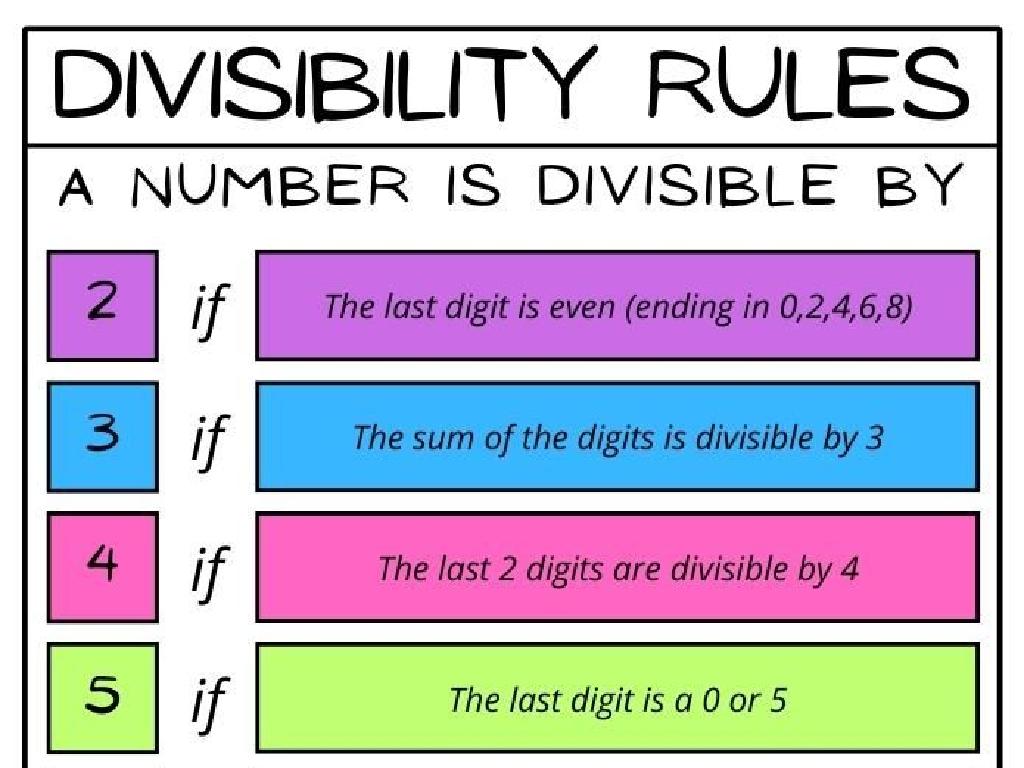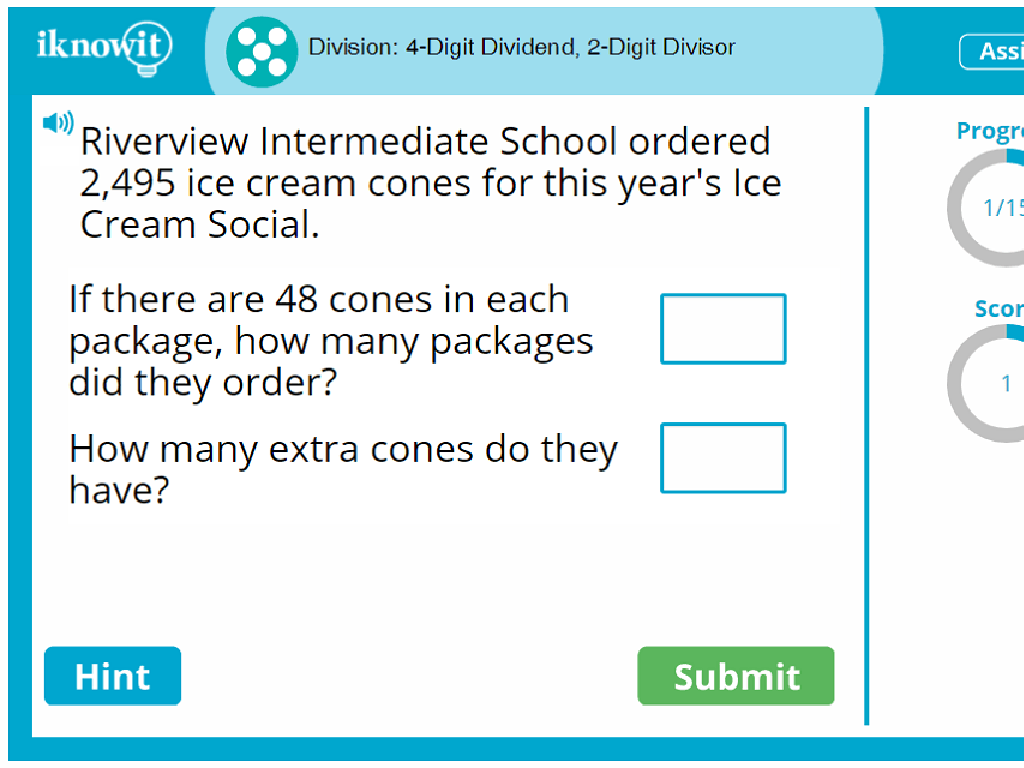Graph Solutions To Multi-Step Inequalities
Subject: Math
Grade: Eighth grade
Topic: One-Variable Inequalities
Please LOG IN to download the presentation. Access is available to registered users only.
View More Content
Introduction to Multi-Step Inequalities
– Recap one-variable inequalities
– Review: solving for x in equations like x + 3 > 5
– Multi-step inequalities explained
– Involves combining like terms, using the distributive property
– Real-life multi-step inequality uses
– Budgeting, cooking, and construction projects often require these calculations
– Solving multi-step inequalities
|
Begin with a brief review of one-variable inequalities to ensure students have a solid foundation. Explain that multi-step inequalities are similar but involve additional steps, such as combining like terms or distributing. Provide relatable examples where these types of inequalities are applicable, such as in budgeting personal finances, measuring ingredients in recipes, or calculating materials needed for a building project. Emphasize the importance of following the correct order of operations and maintaining the inequality’s direction unless multiplying or dividing by a negative number. Encourage students to solve a few simple multi-step inequalities to practice the concepts discussed.
Solving Multi-Step Inequalities
– Combine like terms first
– Like terms have the same variables to the same power. Combine them to simplify the inequality.
– Isolate the variable using inverse operations
– To get the variable alone, use addition, subtraction, multiplication, or division as needed.
– Flip inequality when using negative numbers
– If you multiply or divide by a negative, reverse the inequality sign to maintain the true relationship.
– Check solution by substituting back
– After solving, plug your solution into the original inequality to verify it makes the inequality true.
|
This slide is aimed at guiding students through the process of solving multi-step inequalities. Start by combining like terms to simplify the inequality. Then, use inverse operations to isolate the variable on one side of the inequality. It’s crucial to highlight that when multiplying or dividing both sides of an inequality by a negative number, the inequality sign must be flipped to maintain the correct relationship. Finally, emphasize the importance of checking the solution by substituting it back into the original inequality to ensure it satisfies the condition. Provide examples and encourage students to practice these steps with different inequalities to build their confidence.
Solving Multi-Step Inequalities
– Solve 2(x – 3) > 4 + x
– Distribute and combine like terms
– Apply the distributive property: 2x – 6 > 4 + x
– Isolate the variable x
– Get all x terms on one side: 2x – x > 4 + 6
– Check solution by substitution
– Substitute the solution into the original inequality to verify
|
This slide presents a step-by-step approach to solving a multi-step inequality. Start by distributing the 2 into the parentheses, then move all terms containing x to one side of the inequality to isolate x. After finding the solution, it’s crucial to check the work by substituting the value of x back into the original inequality to ensure it makes the inequality true. This reinforces the concept of inverse operations and the importance of checking work in algebra. Encourage students to follow these steps with similar problems and to always verify their solutions.
Solving Multi-Step Inequalities
– Solve 3(2y + 4) d 2(y – 1) + 10
– Distribute and combine like terms
– Apply the distributive property: 6y + 12 d 2y – 2 + 10
– Isolate the variable y
– Subtract 2y and 12 from both sides: 4y d -4
– Check the solution
– Substitute the solution back into the inequality to verify
|
This slide presents a structured approach to solving multi-step inequalities. Start by distributing the numbers inside the parentheses and then combine like terms to simplify the inequality. Next, isolate the variable on one side of the inequality by performing inverse operations. Emphasize the importance of checking the solution by substituting it back into the original inequality to ensure it makes the inequality true. This step is crucial as it confirms the accuracy of the solution and helps students understand the relationship between the algebraic solution and the graphed solution on a number line.
Graphing Solutions of Multi-Step Inequalities
– Graphical representation of solutions
– Use a number line to show all possible solutions to an inequality
– Open vs. closed circles
– Open circle: value not included, Closed circle: value included
– Practice plotting on number lines
– Take examples of inequalities and mark the solutions on a number line
– Review and apply previous examples
– Revisit past problems to reinforce the concept with practice
|
This slide aims to teach students how to graph the solutions of multi-step inequalities on a number line. Emphasize the importance of understanding the difference between open and closed circles to represent whether a boundary point is included in the solution set. During class, provide students with a range of inequality examples and guide them through the process of plotting these on a number line. Encourage students to refer back to previous examples from the lesson to apply what they’ve learned and solidify their understanding. The activity should be interactive, with students actively participating in plotting points and discussing their reasoning.
Class Activity: Solve and Graph Inequalities
– Solve multi-step inequalities
– Graph solutions on a number line
– Mark the solution set accurately on the line
– Pair up for solution review
– Discuss the solving process and compare graphs
– Share findings with the class
– Present your graph and reasoning to peers
|
This interactive class activity is designed to reinforce students’ understanding of solving and graphing multi-step inequalities. Provide a set of inequalities for students to solve individually, ensuring a range of difficulty to cater to different skill levels. Once solved, students will graph their solutions on a number line, which helps visualize the range of possible solutions. Pairing students encourages collaboration and peer learning, as they review each other’s work and discuss different approaches to solving the inequalities. Conclude the activity with a class sharing session, where pairs can present their findings and explain their reasoning. This will foster communication skills and deepen their understanding of the topic. Possible activities for different students could include solving for variables, graphing inequalities with open/closed circles, and creating their own inequalities based on real-life scenarios.
Homework: Mastering Multi-Step Inequalities
– Complete assigned practice problems
– Create your own multi-step inequalities
– Invent scenarios, form inequalities, and solve them
– Utilize available resources for help
– Online platforms, textbooks, and study groups can assist
– Review and prepare for next class
|
For homework, students should solve the practice problems provided to reinforce their understanding of graphing solutions to multi-step inequalities. Encourage them to create their own problems, which helps deepen comprehension and allows for creativity in applying mathematical concepts. Remind students of the resources at their disposal, such as online tutorials, textbooks, and peer study groups, should they need additional support. In the next class, we will review the homework, address any difficulties encountered, and ensure readiness to move forward. Provide at least 4-5 different types of multi-step inequalities to cater to varying levels of student proficiency and to challenge their problem-solving skills.
Wrapping Up: Multi-Step Inequalities
– Summarize key inequality concepts
– Reviewed solving, graphing multi-step inequalities
– Address final questions
– Ensure understanding before moving on
– Preview next lesson’s topics
– Introduce systems of inequalities
– Encourage practice at home
|
As we conclude today’s lesson on multi-step inequalities, recap the process of solving inequalities, including any special rules like the reversal of the inequality sign when multiplying or dividing by a negative number. Reiterate the importance of checking solutions and graphing them on a number line. Address any lingering questions to ensure students feel confident with the material. Preview the next lesson by briefly mentioning systems of inequalities, setting the stage for continued learning. Encourage students to practice today’s concepts at home to reinforce their skills.





